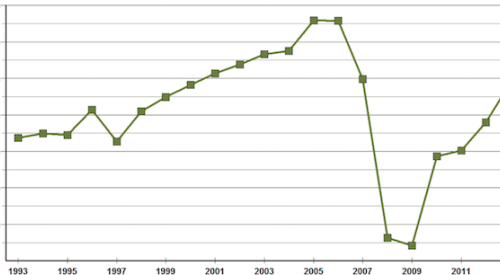There’s too much noise. As executives we need to see and hear intelligence that is relevant for the success of our organizations. Figuratively speaking, we should wear blinders while excellent baroque classical music plays in our headphones. Classical music is like a trend line. It’s soothing, reliable, and stable. Yet noise—weekly economic indicators, monthly housing start numbers, and other short-term statistics—prevents us from recognizing trend lines in our business and acting proactively. Instead, we stutter step. We pay attention to the noise and move forward a bit, but then pull back. We only feel more confident to forge ahead when we see others jump in first. The result is stampede in our industry not unlike the mass migration of a Northern European rodent. I call it the lemming effect.
This recovery is one in which builders would do well to recognize the trend lines and take a steady course of action rather than stutter steps, which can harm your business. We all know of instances when we accidently saved ourselves from a disaster by delaying decisions because we decided we could not decide. In a downward trend-line condition, that conservatism is helpful. But in an upward trend line environment, builders should be more confident about their decision-making. Being too conservative can slow growth. Here are some current scenarios that I see in our industry:
• The trades. Where did they all go? Labor costs are going up.
• Lot Inventory. I had enough for three years but now I’ll be out of lots in 10 months.
• Land development. I can’t find money to improve my raw ground.
• Cash. I don’t have money to build my organization.
• Executives. Where are they? I need them now.
• Back-office chaos. Nothing is under control. My systems are weak, and my variances are not being tracked.
What is a trend line and why does it matter? Trend lines normally head up or down. In the case of our national economic recovery, we have flatlined or stabilized at 2.5-percent GDP growth, meaning the trend line is static and does not feel very encouraging to many of us. The most important aspect of trend lines is that below the surface of the national economy are the resource trend lines and the housing trend lines. These indicators are very positive and driven by very real facts like the backlog in development pipelines and the shortage of homes for sale in some housing markets.
Know the facts and realize whether your overall market conditions are trending positive or negative. Figure out which facts matter most. Those are the bits of information that will not change no matter what happens in the world around us. Make them your trend lines and use that information to solidify your decision-making confidence. Current events can affect the steepness of a trend line, but in most cases they will not reverse the trend.
Trend line confidence
Let’s apply this thinking to your life, reduce those sleepless nights, and improve your operating results. Say a builder secures a large parcel that he must develop, estimate, and cost out. He’s also considering adding a vice president of operations because he needs to ramp up operations. But the idea of increasing overhead costs clashes with his cash-conserving ways. Yet if he delays hiring, then he’ll end up searching for a vice president amid a mass migration of builders who also stutter-stepped and find themselves trying to recruit senior managers just as demand slams the pool of candidates. That builder is worse off than he would have been had he believed in the trend line and acted sooner.
Let’s discuss how acknowledging trends could have helped builders avoid some of these crises mentioned earlier. First, the trades either found something else to do, scaled down their organizations, or left the industry. Once you realized business was recovering, the trend line turned up and the underlying infrastructure was in disrepair. That’s when back office folks needed to start reaching out and implementing support for the trades to come back to the industry. They didn’t and now we have a growing labor shortage caused by stutter steps. This particular trend line is continuing upward and will become more challenging.
Lot inventories and improvement efforts are connected. Builders who understood the cycle time for producing a finished lot and compared that data with improvement activity a year ago would have recognized that land in their markets was heading for a shortage. When the absorption rate is faster than cycle time—which could be anywhere from four to 18 months—the shortage of finished lots is likely. Instead of using historical absorption rates, which lag actual rates, use your own in-house experience on a rolling three-month projection and annualize that figure. For example, if you sold 10 homes in three months, project you will sell 10 x 4 quarters or 40 homes and use that figure to plan your finished lot needs. Don’t use the 12 homes you sold during all of last year during the initial phase of the recovery as your starting point.
Many companies are in a restart mode during a recovery and need more cash so they can scale up. The feeling that your expansion plans are on hold because you don’t have money to invest in your company is a symptom of failing to manage the shift from a buyer’s to a seller’s market. Changing your cash position demands being proactive. See my article about how to raise additional capital by courting equity investors (“The Next Dance, Finding Capital,” PB, April 2013).
You can recover. Find that greatness within, hit the restart button, and stabilize your company. A recovery is the right time to believe in trend lines. GDP, though sluggish, is rising; housing demand is climbing in many markets; lot inventories are declining, and Baby Boomer retirements will create structural changes to our economy that will translate into growth opportunities for builders.
The entire home building environment is gaining speed and the only way you and your organization can keep pace is to admit you must fix all your legacy issues fast. If you are on the sidelines, others are moving past you. First, get your cash position stabilized. Find financing partners and know your market well. Second, get the executives and the technology in place to move forward. Third, figure out the trend lines that matter to you and your organization. Remember jobs are being created somewhere and someone has the ability to establish a household. There are 100-year-old homes that need to be razed and replaced with the 2013 model. We need new houses.

Look in the mirror and be honest. Did the butt-kicking you endured over the last five years make you wiser and stronger, or more conservative and weaker? Is your conservative streak hurting you? I can tell you that most likely it is. Remember our economy recently topped the $16-trillion threshold and, if we had a normal recovery, we should be at $17.4 trillion right now. The European debt crisis, our country’s politicized economic policies, and risk aversion are contributing to the less robust recovery to date, but the trend lines still are moving up. So in your corner of the world, apply the lessons of trend lines, stutter steps, and the lemming effect to your world view and decision-making.
Every builder needs to be accountable for his or her reading of their local market trends, which are imbedded in the bigger marketplace. Our industry is contagious and will eventually infect your market’s performance.
Trying times call for courage when you least possess it. Yet there is a saying that great people are not born rather they appear when conditions converge, merge and cause the essence of their character to be tested. Perhaps all of us have to find that greatness in our character at some point in our lives; perhaps that time is now for those of us in the residential sector.
Noelle Tarabulski is CEO of Builder Consulting Group of Lakewood, Colo., a management consulting firm dedicated to builders and developers since 1991. She can be reached at noellet@buildertools.com.















